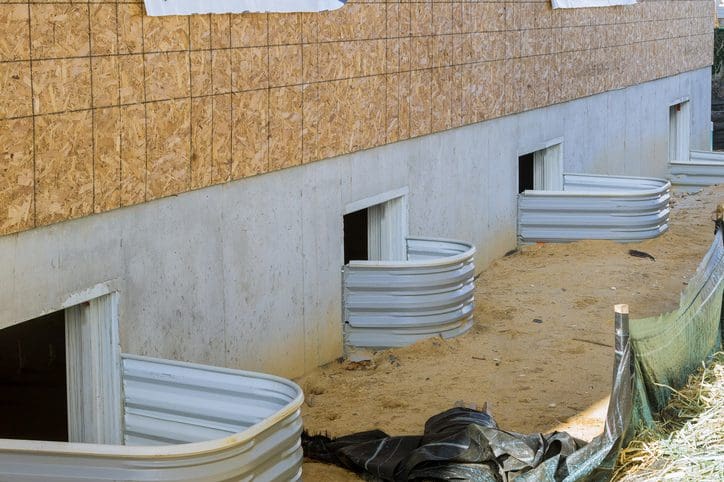



Equipping your home with properly sized gutters and downspouts is one of the most important things you can do to protect it from flood damage. Building professionals use charts, rules of thumb, and experience to size these critical components. Roof area and slope are the key variables. In most cases, gutters should be 5 or 6 inches wide, regardless of type. Size your downspouts accordingly. Smaller components may look nice, but they likely to be overwhelmed in a heavy rainstorm.
Remember to keep gutters free of debris by cleaning them regularly or using leaf guards. Discharge water to daylight at least 10 feet and, if possible, downhill from the house. Never connect roof drains to foundation drains. They can become clogged with debris.
It’s never a good idea to deposit water on your neighbor’s property or on public roads. Some towns will permit you to connect your roof drains directly to the municipal storm sewer system. Check with your town engineer for more information.

Wide roof eaves have been a common building feature for thousands of years–and for good reason. In addition to their aesthetic benefits, wide eaves help to keep rainwater away from your home’s walls, both above and below grade.
Even if the gutters and downspouts are overwhelmed during a deluge, wide eaves provide added protection by diverting roof runoff from the foundation walls. Preventing the soil against your foundation from being saturated will reduce the odds of flood damage in your basement.

Making sure the soil around your home slopes away from the foundation wall will have a similar effect. Properly directed surface water is less likely to end up your basement.
Fill in and compact any low spots where water might pool and infiltrate the soil. Soil settlement often occurs in the years after construction or excavation work.

Foundation wall windows and fresh air vents that are partially or completely below grade are a conduit for surface water and a major cause of flood damage in homes. If you feel these openings are not necessary, then consider infilling them. Otherwise, install covered and drained window wells around them.
Covers keep out debris and most surface water, and drains at well bottoms take care of any water that manages to get in.
If your property is not absolutely flat, discharge the water to daylight at a lower elevation away from the house. On flat sites, direct water into a sump pit, which ejects it to a rain garden away from the house.
As noted above, avoid connecting a window well drain to an exterior foundation drain.

Even if you’ve done everything you can to keep water from getting into your basement, it may still find its way in during or after a heavy rain. In that case, the combination of French drain and sump pump can be an indispensable ally.
A French drain is a network of perforated pipes designed to relieve hydrostatic pressure that would otherwise build up under the floor slab and outside the foundation walls. The pipes collect this excess water and deposit it in a sump pit or basin. When the pit is nearly full, a pump ejects the water through a pipe to the exterior. As with roof drains, the water should be discharged to daylight, far and downhill from the house.
I consider a properly functioning French drain and sump pump system to be essential protection from flood damage. With these components, water that enters your basement will have a place to go. Without them, you may experience significant flood damage after a storm, not to mention emotional stress.
After yet another torrential downpour, you watch with satisfaction as your sump pump dutifully ejects gallon after gallon of water from the sump pit. But it’s precisely when you need it most that a pump can fail, from either overwork or a power outage.
What’s your Plan B? Water-powered backup pumps, such as the grey Liberty Pumps Sumpjet in the photo above, are worth considering. Although they can’t move water as quickly as an electric sump pump, and they are powered by your municipal water system (which you pay for), these relatively inexpensive wonders can be your last line of defense against serious flood damage and property loss.

Is your primary motivation for installing a backup generator is to ensure that your sump pump will function during a power outage? It will certainly do that, however it’s not the least costly way to protect your home against flood damage.
Of course, there are numerous good reasons to install a generator. Maintaining your family’s comfort and peace of mind during a power outage tops the list.

To a growing family looking for a cost-efficient way to add living space to their home, finishing the basement seems like a great option.
While this logic has some merit, finishing a space below grade has always come with some risk. Basements in our area have long been known to flood from time to time. And this risk will increase if current weather trends continue as climate experts predict they will.
The first and biggest mistake homeowners make when they embark on such a project is to use materials that can be damaged by water. Even without a flood, drywall, wood, fiberglass insulation, and carpeting can become a moldy nightmare. That’s because of the elevated moisture levels in most foundation walls and floor slabs.
The second mistake is to fill the space with items that can be damaged during a flood. Furniture and children’s toys are especially vulnerable.
After a flood or over time, these materials will harbor mold, decay, and cause health problems to a home’s occupants. This scenario is especially common in older homes.
Armed with a more complete understanding of building science principles, today’s design professionals can create safe, healthy, and durable finished spaces below grade.










300 Witherspoon Street, Suite 201, Princeton, New Jersey 08542
609.737.6444
© Douglas R. Schotland Architect, LLC 2025